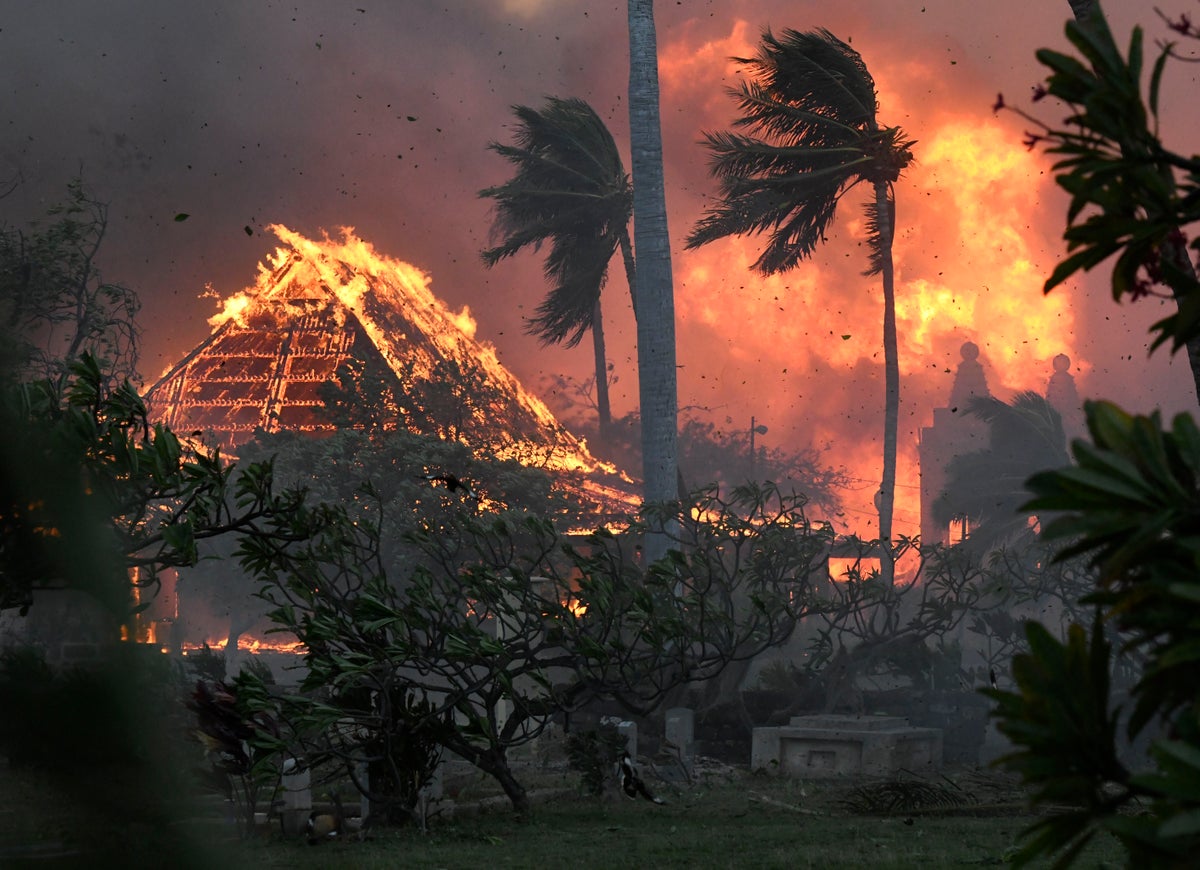
Highly flammable grass is believed to have fuelled the rapid spread of the deadly wildfires in Maui that have killed at least 111 people and destroyed the island’s historic town of Lahaina.
Experts say the invasive, non-native grassland that covers a quarter of the Hawaii islands has been a major fire risk they have been warning about for years.
The types of grass, including guinea grass, molasses grass and buffel grass, originated in Africa but were brought to Hawaii for livestock because it proved drought-resistant.
“These grasses are highly aggressive, grow very fast and are highly flammable,” Melissa Chimera, who coordinates the Pacific Fire Exchange, a Hawaii-based project sharing fire science among Pacific island governments, told The New York Times.
“That’s a recipe for fires that are a lot larger and a lot more destructive,” Ms Chimera added. Her grandmother lived on the Hawaiian Commercial & Sugar Co.’s plantation in Maui after emigrating from the Philippines.
In just a matter of weeks earlier this year, Hawaii went from lush to bone dry and thus more fire-prone. At the end of May, Maui was more than half abnormally dry and by June 13 it was two-thirds either abnormally dry or in moderate drought, The Associated Press reported.
And this week about 83 per cent of the island is either abnormally dry or in moderate or severe drought, according to the US drought monitor.
Several experts say climate change is increasing the likelihood of these flash droughts.
The state’s local power grid and vegetation coming in contact with power lines are factors that have also been blamed for the wildfires.
Clay Trauernicht, a specialist in wildland fire science and management at the University of Hawaii at Manoa, tweeted that the massive amounts of non-native grasslands are at fault for the current wildfires that are ravaging Maui.
“Yes many parts of Hawai’i are trending towards dryer conditions, BUT the fire problem is mostly attributable to the vast extents of nonnative grasslands left unmanaged by large landowners as we’ve entered a ‘post-plantation era’ starting around the 1990s,” Mr Trauernicht wrote.
Mr Trauernicht previously wrote a letter to the Maui News about concerns during the wildfires in 2018 that scorched the land and destroyed 21 homes.
“The fuels — all that grass — is the one thing that we can directly change to reduce fire risk,” he wrote.
Mr Trauernicht said that by using grazing animals, for example, could have tamed the fire’s intensity, while farming activity, reforestation or fire breaks might have slowed its progress.
He was quoted in a July 2021 report on wildfire prevention by a Maui government commission describing the wildfire season in Hawaii as a “one-two punch” of wet then dry conditions.
During the wetter part of the year, “a lot of vegetation and particularly grasses … grow and grow very fast,” he said.
Then, in the dry period, the grasses turn “from green to yellow to brown pretty quickly … making us way more vulnerable to these big, destructive fires”.
Elizabeth Pickett, the co-executive director of the Hawaii Wildfire Management Organization, said massive tracts of land used to be occupied by irrigated pineapples and sugar cane.
But as those businesses declined and ceased, the land was taken over by the fire-prone grass species.
“The problem is at such a large scale, 26 per cent of our state is now invaded by these grasses,” she said. “The landscape that has been invaded is steep, rocky and challenging to access. It’s a really hard landscape. You can’t just go with a lawn mower.”
Professor Abby Frazier, a climatologist who studied in Hawaii and is now at Clark University in Massachusetts, said the Maui fires were no surprise, although the human toll was shocking.
“I never expected it to be this bad in terms of lives lost. It is shocking and gut-wrenching, but the fire itself was not a surprise.”
Ms Frazier said “the overall cause of this fire being so large was the invasive grasses”.
However, the exact cause of the wildfires started remains a mystery but security footage shared by a bird sanctuary in Maui may point to some answers.
Security footage shared by a bird sanctuary in Maui may point to some answers.
The video shows, what some believe, to be a tree falling on a power line resulting in a bright flame that continued to burn.
The wildfires broke out on 8 August and were fast-moving leaving little time for people in Lahaina to evacuate.
Over 2,000 buildings and homes have been burned and 1,000 people are still missing.
With only 35 per cent of the burned area searched, Hawaii governor Josh Green said he expects the death toll to rise in the coming days.
As recovery efforts are underway, President Joe Biden and First Lady Jill Biden said they will travel to Maui on Monday, 21 August to meet with local, state and federal officials as well as victims.







